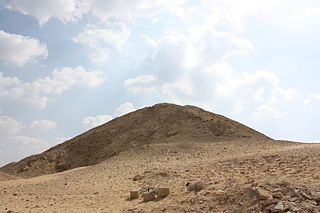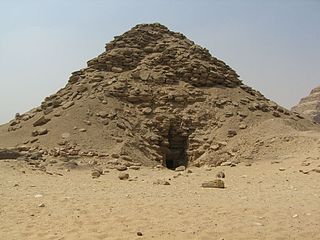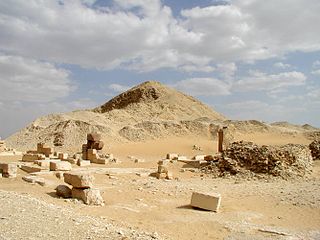
Qakare Ibi was an ancient Egyptian pharaoh during the early First Intermediate Period and the 14th ruler of the Eighth Dynasty. As such Qakare Ibi's seat of power was Memphis and he probably did not hold power over all of Egypt. Qakare Ibi is one of the best attested pharaohs of the Eighth Dynasty due to the discovery of his small pyramid in South Saqqara.

The Sixth Dynasty of ancient Egypt, along with the Third, Fourth and Fifth Dynasty, constitutes the Old Kingdom of Dynastic Egypt.

Userkare Khendjer was a minor king of the early Thirteenth Dynasty of Egypt during the Middle Kingdom. Khendjer possibly reigned for four to five years, archaeological attestations show that he was on the throne for at least three or four years three months and five days. Khendjer had a small pyramid built for himself in Saqqara and it is therefore likely that his capital was in Memphis.

Smenkhkare Imyremeshaw was a minor king of the early 13th Dynasty during the late Middle Kingdom. He apparently had a short reign and is mainly attested in the Memphis-Faiyum region in Egypt.

The Layer Pyramid is a ruined step pyramid dating to the 3rd Dynasty of Egypt and located in the necropolis of Zawyet El Aryan. Its ownership is uncertain and may be attributable to king Khaba. The pyramid architecture, however, is very similar to that of the Buried Pyramid of king Sekhemkhet and for this reason is firmly datable to the 3rd Dynasty.

The pyramid of Teti is a smooth-sided pyramid situated in the pyramid field at Saqqara in Egypt. It is the second known pyramid containing pyramid texts. Excavations have revealed a satellite pyramid, two pyramids of queens accompanied by cult structures, and a funerary temple. The pyramid was opened by Gaston Maspero in 1882 and the complex explored during several campaigns ranging from 1907 to 1965. It was originally called Teti's Places Are Enduring. The preservation above ground is very poor, and it now resembles a small hill. Below ground the chambers and corridors are very well preserved.

The pyramid of Khendjer was a pyramid built for the burial of the 13th dynasty pharaoh Khendjer, who ruled Egypt c. 1760 BC during the Second Intermediate Period. The pyramid, which is part of larger complex comprising a mortuary temple, a chapel, two enclosure walls and a subsidiary pyramid, originally stood around 37 m (121 ft) high and is now completely ruined. The pyramidion was discovered during excavations under the direction of Gustave Jéquier in 1929, indicating that the pyramid was finished during Khendjer's lifetime. It is the only pyramid known to have been completed during the 13th Dynasty.

The pyramid complex of Userkaf was built c. 2490 BC for the king Userkaf, founder of the 5th Dynasty of Egypt. It is located in the pyramid field at Saqqara, on the north-east of the step pyramid of Djoser. Constructed in dressed stone with a core of rubble, the pyramid is now ruined and resembles a conical hill in the sands of Saqqara. For this reason, it is known locally as El-Haram el-Maharbish, the "Heap of Stone", and was recognized as a royal pyramid by western archaeologists in the 19th century.

The Mastabat al-Fir'aun, also referred to in Egyptological literature as the Mastaba el-Faraun, Mastabat el-Faraun or Mastabat Faraun, and meaning "Bench of the Pharaoh") is the grave monument of the ancient Egyptian king Shepseskaf, the last king of the Fourth Dynasty documented to date. It is located in South Saqqara halfway between the Pyramid of Djoser at Saqqara and the pyramids of Sneferu, the founder of the Fourth Dynasty, at Dahshur. The structure is located close to the pyramid of Pepi II, a ruler of the Sixth Dynasty. The stone quarry for the structure is located west of the Red Pyramid of Sneferu.

The pyramid of Neferefre, also known as the pyramid of Raneferef, is a 25th century BC unfinished pyramid complex built for the Egyptian pharaoh Neferefre of the Fifth Dynasty. Neferefre's unfinished pyramid is the third and final one built on the Abusir diagonal – a figurative line connecting the Abusir pyramids with Heliopolis – of the necropolis, sited south-west of Neferirkare's pyramid.
The pyramid of Pepi I is the pyramid complex built for the Egyptian pharaoh Pepi I of the Sixth Dynasty in the 24th or 23rd century BC. The complex gave its name to the capital city of Egypt, Memphis. As in the pyramids of his predecessors, Pepi I's substructure was filled with vertical columns of hieroglyphic texts, Pyramid Texts. It was in Pepi I's pyramid that these texts were initially discovered in 1880 by Gaston Maspero, though they originated in the pyramid of Unas. The corpus of Pepi I's texts is also the largest from the Old Kingdom, comprising 2,263 columns and lines of hieroglyphs.

The pyramid of Pharaoh Merenre was constructed for Merenre Nemtyemsaf I during the Sixth Dynasty of Egypt at Saqqara 450 metres (1,480 ft) to the south-west of the pyramid of Pepi I and a similar distance to the pyramid of Djedkare. Its ancient name was "Merenre's beauty shines" or perhaps "The Perfection of Merenre Appears". Today it consists mostly of ruins; it is hard to get to and is not open to the public.

Sekhemre Sementawy Djehuty was a minor king reigning over parts of Upper Egypt during the Second Intermediate Period.
The Headless Pyramid, otherwise identified as Lepsius XXIX, is the remain of a pyramid complex built in Saqqara. The identity of the pyramid owner is unclear, though it is suspected to belong to either pharaoh Menkauhor of the Fifth Dynasty or pharaoh Merikare of the Tenth Dynasty, both of whom are known to have built a pyramid. If associated with Menkauhor, the pyramid's name is Nṯr-ỉswt Mn-kꜣw-ḥr meaning 'Divine are the places of Menkauhor'; if associated with Merikare, the pyramid's name is Wꜣḏ-swt Mry-kꜣ-rꜥ meaning 'Fresh are the places of Merikare'. Other candidates for the pyramid owner that have been proposed are Amenemhat I of the Twelfth Dynasty and an ephemeral pharaoh Ity of the Eighth Dynasty.

The Southern Mazghuna Pyramid is an ancient Egyptian royal tomb which was built during the 12th or the 13th Dynasty in Mazghuna, 5 km south of Dahshur, Egypt. The building was never finished, and is still unknown which pharaoh was the owner, since no appropriate inscription have been found.
The pyramid was rediscovered in 1910 by Ernest Mackay and excavated in the following year by Flinders Petrie.

The Northern Mazghuna Pyramid is an ancient Egyptian royal tomb which was built during the 12th or 13th Dynasty in Mazghuna, 5 km south of Dahshur. The building remained unfinished, and it is still unknown which pharaoh was really intended to be buried here since no appropriate inscription has been found.
The pyramid of Reherishefnakht is the tomb of the ancient Egyptian official Reherishefnakht. It is located in south Saqqara and was built right next to the pyramid of the 6th Dynasty pharaoh Pepi I. Reherishefnakht's pyramid however was probably built at the end of the 11th Dynasty or the beginning of the 12th Dynasty. It is the oldest Egyptian pyramid built for a person who was not a member of the royal family. The pyramid was discovered a few years before it was first excavated by Audran Labrousse and the Mission Archéologique Française de Saqqâra in 2005.
The pyramid of Ity was probably the tomb of Pharaoh Ity who reigned during the 8th dynasty. It has never been discovered and is known only from a cliff-face inscription at Wadi Hammamat in the Eastern Desert, where there were several quarries in Pharaonic times.
The pyramid of Neferkare Neby was the tomb of the Ancient Egyptian King Neferkare Neby, who reigned in the 8th Dynasty. It has never been located and is only known from an inscription.

The pyramid of Pepi II was the tomb of Pharaoh Pepi II, located in southern Saqqara, to the northwest of the Mastabat al-Fir’aun. It was the final full pyramid complex to be built in Ancient Egypt. Long used as a quarry, the pyramid was excavated for the first time by Gaston Maspero in 1881. Its ruins were studied in exhaustive detail by Gustave Jéquier, who was able to reconstruct the funerary complex and the texts on the walls of the funerary chamber in the course of his excavation campaigns from 1932–1935. Since 1996, thorough investigations of the pyramid and its surroundings have been being carried out by the Mission a.

















